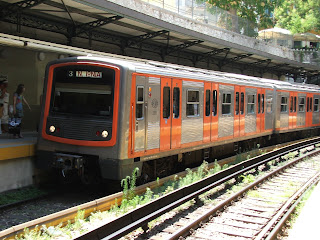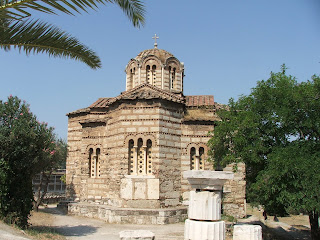

Piraeus is probably one of the busiest ports in the Mediterranean, and entering and departing the port area can be time consuming. As we entered the port area on the morning we arrived, the sun was just coming up over the mountains to heat up the city. Athens is notorious for being an incredibly hot and sweltering city. Even at this early hour, we could already see that the port was busy. Due to the size of the ship, we had to dock at the pier that is the furthest away from the main part of town. Once we were allowed to disembark the ship, we caught a complimentary port shuttle from our ship to the port entrance. I guess the distance may have been walkable, but it would have added at least 20 minutes (if not more) to our travel time.

The walk from the port entrance to the metro station was a 20 minute walk through the very busy port area of Piraeus. At the very least, it was a flat surface, just long in distance. But even at just past 6:00 am, it was already hot and oppressive, I didn't even want to think of how it would be in the afternoon.

When we finally made it to the Metro station, the rest was easy. Tickets were cheap, and when we walked to the platform, the train was already waiting. Trains depart from Piraeus (the origination point) in the direction of Athens every few minutes. The travel time into Athens wasn't more than about 20 minutes. After much research, I decided that the easiest route for us would be to disembark the train at the Monastirion (or Monstraki) station. From the station, it would be a straight shot (though on a steep incline) to the Acropolis.

Once we exited the Monstiraki station, we looked to our left and saw nothing. We looked to our right, and there it was. High above the rock that seems to rise up out of nowhere, the outlines of some of the buildings that sit atop the Acropolis. And off we went, through parts of the Plaka, through a small neighborhood, and up the backside of the Acropolis. And boy, the climb to the top was incredibly steep.
By the time we arrived at the Acropolis ticket office, it was just past 8:00 am. This was good because we wanted to get there as close to opening time (8:00 am) as possible to avoid the large crowds we knew would soon be arriving.


The Acropolis is much the same as I remember it from 3 years ago, except perhaps the fact that there seemed to be less renovation/reconstruction work being done on the buildings atop the Acropolis than there was my first time around. This was good because it afforded everyone a better view of many of these historic buildings.


As you make your way up past the entrance to the Acropolis the first building you come to is the Porpylea and the Temple of Athena Nike. The Propylea is widely regarded as the gateway to the Acropolis. The first time I visited the Acropolis, the Propylea was very difficult to see because it was almost completely covered in scaffolding, and while there was still some scaffolding covering part of the structure this time around, it was much less evident.


Once atop the Acropolis, the two, still-standing buildings on the top of the rock become evident, the magnificent Parthenon and the elegant Erectheion with its very famous caryatid statues. Standing amidst all of the history that the Acropolis represents is a very powerful feeling. To see the 6 famous female pillar statues, known as caryatids, that hold up the portico of the Erectheion is something to behold. It's certainly a thing of beauty. Unfortunately, due to pollution, and the looting of Acropolis marbles by Lord Elgin, the pillars that stand atop the Acropolis today are just replicas. 5 of the original 6 stand inside the New Acropolis Museum and the sixth statue stands inside the British Museum in London. To think that these statues have withstood the test of time and have been witness to most of modern history is beyond imagination.
The Parthenon itself stands as a sort of pillar of strength. It's remarkable that through it's use as a religious place of worship to being used as a munitions storehouse, its outer facade remain in relatively good condition. While the insides of the building have not yet been fully reconstructed due to the damage it sustained when the gun power stored inside exploded and blew the building to pieces, what archaeologists and preservationists have been able to to put together is breathtaking. I can only imagine the painstaking work that goes into accurately recreating history.


One of the amazing aspects of standing atop the Acropolis that I never thought about before is the astounding view of Athens that you see. The city, spread out before your eyes, buildings, people, cars, all bunched together as far as the eye can see. Athens is not a small city like many of the other historical medieval towns you see through Europe, but rather it is a densely populated, large city. From atop the Acropolis, you can spot many of Athens other major tourist sites: the remains Temple of Olympian Zeus, one of the Seven Ancient Wonders of the World; the original Olympic Stadium; the Roman Agora; and the Ancient Agora, among others.


After we had explored the Acropolis, we walked down the rock on it's south side. As you make your way back down towards the city, there are yet more ruins on the south side of the Acropolis, including the delightful Theater of Dionysus. As you exit the south side gates to the Acropolis, just down the street is the New Acropolis Museum.


For years, the Acropolis Museum was a small structure that was housed atop the Acropolis, near the Parthenon. However, in June of 2009, the brand 4-story New Acropolis Museum was opened to the public. This completely glass encased building, provides absolutely stunning views up to the Acropolis and the Parthenon. As I am sure is true for much of the city of Athens, as construction crews began to dig up the ground to lay the foundation for the new museum, they discovered ruins of ancient dwellings, and artifacts from buildings and people long since gone. Rather than destroy these ruins for the purposes of constructing a museum, the museum built it's foundation over the ruins, leaving the space unexposed below so that visitors to the museum could look down into the ground through open-air openings, or under glass covered walkways. The museum itself is extremely well constructed. The sheer amount of artifacts that it houses, and all of the side relief panels from the Parthenon that it has been able to reconstruct and rebuild is extraordinary. The displays are very well done, and very well sign-posted in English. To me, the highlight of the museum was the 5 original caryatid statues that stand inside, with a spotlight shining down to where the 6th statue should stand if Greece gets its way and England returns its prize. The only disappointing part of the museum is that photography is strictly prohibited.
From the New Acropolis Museum, we headed back towards the Acropolis and over to the north side where the Ancient Agora sits just below the Acropolis. The Ancient Agora is one of two agoras in Athens. The other being the Roman Agora. As we have visited both previously, we didn't see a need to visit both again this time. The nice thing about buying a ticket to the Acropolis is that the entrance ticket also includes entrance to other sites such as the Ancient Agora, the Roman Agora, and the Temple of Olympian Zeus. As it was just about noon time now, the sun was high in the sky and the temperatures were sky high. This made the prospect of walking the grounds of the Ancient Agora difficult to fathom. So, instead, I merely walked through bits and pieces of it, without really taking the time to explore it. I was too hot and tired to even make it across the bridge and up to the Temple of Hephaestus that is there. My justification being that I've been here before.


From the Ancient Agora we decided that was enough of the ancient ruins for one day and it was time to explore the Plaka, the outdoor shopping, dining, and people-watching area of Athens. There are streets of stalls filled with merchants peddling their wares to tourists all in an outdoor, open-air setting. The atmosphere is electrifying, the goods bright and colorful to attract attention, and the people ready to have a good time. One could spend hours wandering through this smorgasbord of goods.

After a few hours, the heat and exhaustion set in and we decided it was time to head back to the Metro station, get on the train, and head back for Piraeus. The ride back was just as smooth and easy as the ride there. However, instead of killing ourselves and walking the 20 minutes from the metro station back to the ship in Piraeus, we opted to catch the local bus that would take us to a stop just outside the port entrance. That was one of the smartest ideas we had on this trip.
All in all, it was a good day in Athens. A little bit of a history, a little bit of culture, and a lot of fun. I've often heard people who have visited Athens lament as to how dirty and polluted and un-entertaining of a city it is. But I don't see it. There is such an array of activity in this city buzzing with action, all the while hiding and preserving some of the biggest historical gems to be found anywhere in the world.
No comments:
Post a Comment